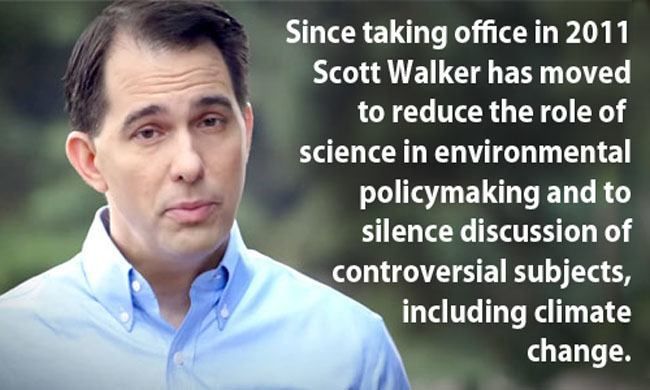

There’s been buzz for a couple of years around the potential presidential campaign of Wisconsin Gov. Scott Walker. Today he made it official: he’s running and is now the 15th candidate to enter the GOP presidential race.

Walker has been widely touted as a frontrunner and someone who actually could snag the nomination, unlike some of the candidates in the crowded field. But his record of failure in his own state—sinking wages, largest loss of middle class in the U.S., population outflow, increased government secrecy, top aides convicted and a federal investigation into possible abuses of his offices continuing—hasn’t been widely scrutinized yet.
And of course, that includes a dismal record on the environment. He doesn’t have any outrageous climate denier statements on record, but he does have a history of coziness with fossil fuel interests and climate deniers, and a resume of attacks on environmental regulations, two things that are probably connected.
According to a recent article in Scientific American, “Since taking office in 2011 Walker has moved to reduce the role of science in environmental policymaking and to silence discussion of controversial subjects, including climate change, by state employees. And he has presided over a series of controversial rollbacks in environmental protection, including relaxing laws governing iron mining and building on wetlands, in both cases to help specific companies avoid regulatory roadblocks. Among other policy changes, he has also loosened restrictions on phosphorus pollution in state waterways, tried to restrict wind energy development and proposed ending funding for a major renewable energy research program housed at the University of Wisconsin–Madison.”
“He really has gone after every single piece of environmental protection: Land, air, water—he’s left no stone unturned,” said Kerry Schumann, executive director of the Wisconsin League of Conservation Voters (LCV). “It’s hard to imagine anyone has done worse.”
Walker proposed cutting 57 employees at the state Department of Natural Resources (DNR) as part of his 2016-2017 budget including 27 in the Bureau of Natural Sciences, although the final budget, which Walker signed this weekend, only cut 18. But that budget is stuffed with anti-environment policy items.
“I hate hyperbole, but I can honestly say that this is one of the two worst conservation budgets in the past 50 years,” said George Meyer, former DNR secretary and now executive director of the Wisconsin Wildlife Federation.
The Wisconsin LCV pointed to a few “lowlights.” The budget removed water quality protections from rivers and lakes in 30 counties which depend on activities such as boating, fishing and swimming to attract tourism, barring them from setting regulations stricter than the state’s. It cut all subsidies for state parks, which comprised 28 percent of their funding, making it the first state park system totally dependent on user fees. It prohibited local governments from requiring that pipeline companies have enough insurance to deal with cleanup from potential oil spills while also included incentives for Canada’s Enbridge to expand pipelines to bring tar sands oil through Wisconsin.

 233k
233k  41k
41k  Subscribe
Subscribe 